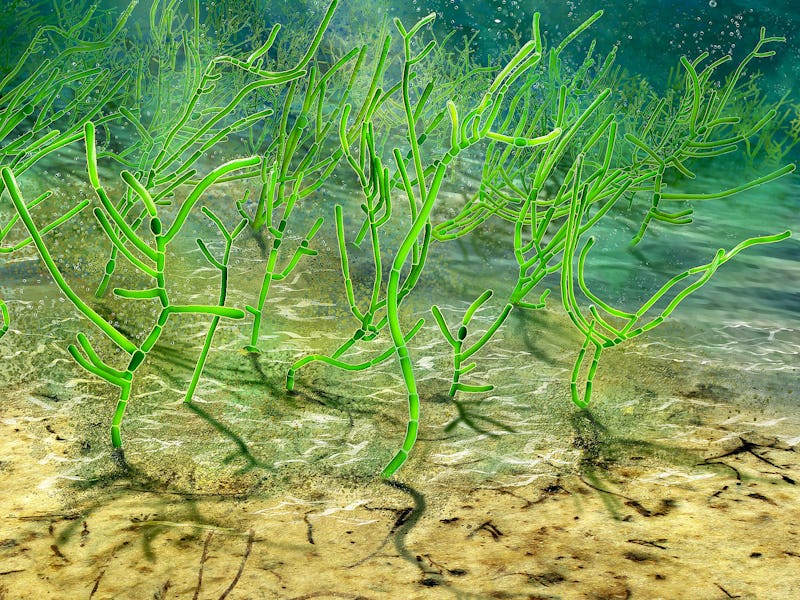A billion-year-old seaweed fossil has completely rewritten ancient history
"Our study tells us that the ubiquitous green plants we see today can be traced back to at least 1 billion years."

Paleontologists announced on Monday the discovery of a billion-year-old green seaweed fossil, evidence of something way older than land-based plants, an ancestor to everything that grows on Earth.
In a study published in the journal Nature Ecology & Evolution , researchers from Virginia Tech write that the seaweed, Proterocladus antiquus, is likely the ancestor of the very first land-based plants and trees on Earth, which showed up around 450 million years ago.
Scientists found this seaweed microfossil in a rock near the city of Dailan in northern China, and the seaweeds are tiny, at around 2 millimeters long. Despite their size, these early algae may have paved the way for the earliest plant species to evolve 650 million years later.
Surprisingly, the microfossils reveal that these ancient weeds closely resemble a group of modern green seaweeds, known siphonocladaleans, which are roughly the same size and shape as the fossilized algae.
Billion-year-old fossilized green seaweed under a microscope.
They also reveal some sketchy details of Earth a billion years back. These seaweeds likely lived in a shallow ocean, before they died and “cooked” under layers of rock, the researchers say. That land is dry today, allowing researchers to dig in and gather the well-preserved fossilized samples.
"These new fossils suggest that green seaweeds were important players in the ocean long before their land-plant descendants moved and took control of dry land," Shuhai Xiao, professor at Virginia Tech and co-author of the new paper, said in a statement.
Previously, the oldest green seaweed fossil discovery dated back a mere 800 million years, but the age of the new fossils completely rewrites the story of how and when the Earth's flora evolved.
"Our study tells us that the ubiquitous green plants we see today can be traced back to at least 1 billion years," Xiao said.
Early plants fed modern ecosystems
To provide the basis of life as we know it today, the earliest marine ecosystems needed food and oxygen — and plants and algae supplied it.
Two billion years ago, there were no green plants in the ocean, Xiao said. But today, plants (and the process of photosynthesis) are vital to life on Earth. One of the major theories of how that plant life emerged is that it all started with the humble seaweed: Over millions of years, these early plants made their way out of the water and onto land, taking root and diversifying into the trees, grasses, bushes, and even houseplants that we know and love today.
Geobiology professor Shuhai Xiao (right) and postdoctorate researcher Qing Tang in their Derring Hall lab.
The new discovery seems to confirm that theory, the researchers say.
"These fossils are related to the ancestors of all the modern land plants we see today," Xiao said.
Not all scientists agree that modern-day greenery evolved from marine plant life, however.
"Not everyone agrees with us; some scientists think that green plants started in rivers and lakes, and then conquered the ocean and land later," he said."
Artist's rendering of Earth's earliest green seaweed.
Apart from green seaweed, brown and red seaweed were also present during these early years, too. In 2017, researchers unearthed 1.6 billion year old red algae fossils, as Reuters reported at the time.
Abstract: Chlorophytes (representing a clade within the Viridiplantae and a sister group of the Streptophyta) probably dominated marine export bioproductivity and played a key role in facilitating ecosystem complexity before the Mesozoic diversification of phototrophic eukaryotes such as diatoms, coccolithophorans and dinoflagellates. Molecular clock and biomarker data indicate that chlorophytes diverged in the Mesoproterozoic or early Neoproterozoic, followed by their subsequent phylogenetic diversification, multicellular evolution and ecological expansion in the late Neoproterozoic and Palaeozoic. This model, however, has not been rigorously tested with palaeontological data because of the scarcity of Proterozoic chlorophyte fossils. Here we report abundant millimetre-sized, multicellular and morphologically differentiated macrofossils from rocks approximately 1,000 million years ago. These fossils are described as Proterocladus antiquus new species and are interpreted as benthic siphonocladalean chlorophytes, suggesting that chlorophytes acquired macroscopic size, multicellularity and cellular differentiation nearly a billion years ago, much earlier than previously thought.